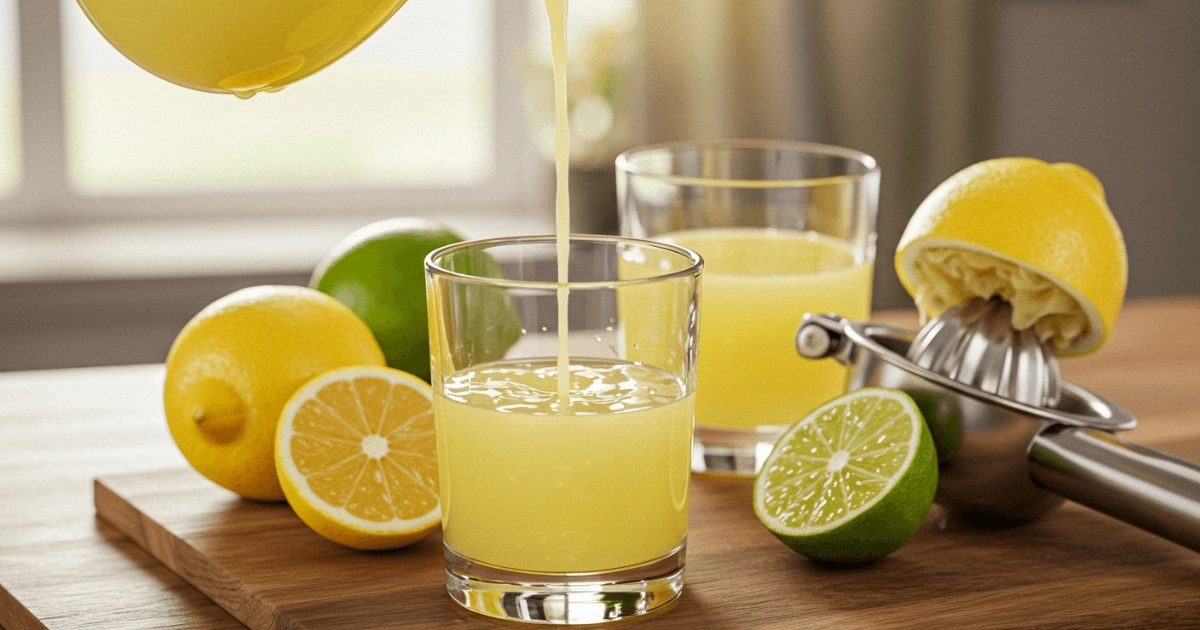
There’s nothing quite like the bright, invigorating taste of fresh lemon juice to kickstart your day. In a world where bottled alternatives are readily available, learning how to make the perfect fresh lemon juice at home can transform your daily routine into a more vibrant and healthy experience. Whether you’re looking to boost your immune system, enhance your morning water, or add a zesty touch to your favorite recipes, mastering the art of fresh lemon juice extraction is a game-changer.
In this comprehensive guide, we’ll walk you through everything you need to know about creating the perfect fresh lemon juice – from selecting the juiciest lemons to proper storage techniques that preserve that just-squeezed freshness. Get ready to discover why homemade lemon juice isn’t just better tasting, but also more beneficial for your overall wellbeing.
Essential Benefits of Fresh Lemon Juice
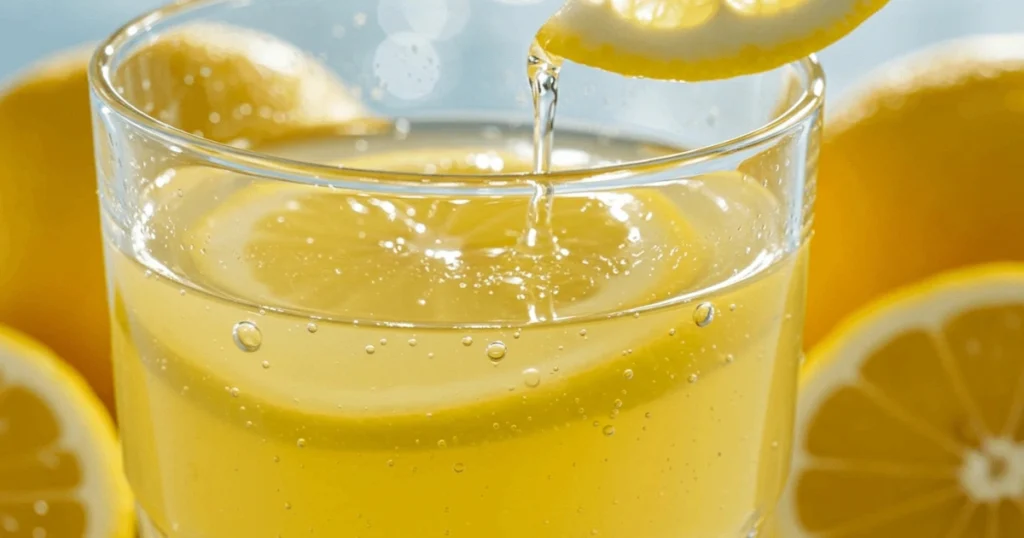
Natural Source of Vitamin C and Antioxidants
Fresh lemon juice is a powerhouse of essential nutrients, particularly vitamin C and antioxidants. A single lemon can provide up to 30-40% of your daily recommended vitamin C intake. Here’s why these nutrients are crucial for your health:
Vitamin C Content:
- One fresh lemon contains approximately 18.6 mg of vitamin C
- The juice from half a lemon provides about 15-30% of your daily vitamin C needs
- Freshly squeezed juice retains more vitamin C compared to store-bought alternatives
Antioxidant Properties:
- Contains powerful flavonoids like hesperidin and diosmin
- Rich in citrus bioflavonoids that combat free radicals
- Features limonene, a natural compound with anti-inflammatory properties
Health Benefits:
- Supports collagen production for healthy skin
- Enhances iron absorption from plant-based foods
- Strengthens immune system function
- Protects cells from oxidative stress
Maximizing Nutrient Content:
- Use lemons immediately after cutting
- Avoid exposing juice to air for long periods
- Store properly to maintain vitamin content
- Consume fresh rather than processed juice
Aids Digestion and Detoxification
Fresh lemon juice plays a crucial role in supporting digestive health and natural detoxification processes. Here’s a detailed look at how this citrus powerhouse benefits your digestive system:
Digestive Benefits:
- Stimulates production of digestive juices
- Helps break down food more efficiently
- Reduces bloating and indigestion
- Maintains optimal pH levels in the stomach
Detoxification Support:
- Enhances liver function
- Stimulates bile production
- Helps flush out toxins
- Supports kidney function through natural diuretic properties
How It Works:
- Enzyme Production:
- Triggers digestive enzyme release
- Improves nutrient absorption
- Helps break down complex foods
- Liver Support:
- Promotes natural cleansing processes
- Supports glutathione production
- Aids in toxin elimination
Best Ways to Use:
- Drink warm lemon water first thing in morning
- Add to meals as a digestive aid
- Use as salad dressing base
- Mix with herbal teas for enhanced benefits
Pro Tips:
- Start with small amounts and gradually increase
- Always dilute pure lemon juice
- Consume through a straw to protect tooth enamel
- Use organic lemons when possible for maximum benefits
Boosts Immune System Function
Fresh lemon juice is a powerful immune system booster, providing essential nutrients and compounds that help strengthen your body’s natural defenses. Here’s a detailed look at how lemon juice supports immune health:
Key Immune-Boosting Components:
- High concentration of Vitamin C
- Natural antibacterial properties
- Potassium content
- Citrus bioflavonoids
Immune System Benefits:
- Vitamin C Support:
- Stimulates white blood cell production
- Enhances antibody response
- Helps create protective barrier against pathogens
- Reduces duration of common cold symptoms
- Antimicrobial Properties:
- Natural antibacterial effects
- Helps fight off harmful microorganisms
- Supports throat health
- Assists in preventing infections
Optimal Usage for Immune Support:
- Consume 1-2 tablespoons daily
- Mix with warm water in the morning
- Combine with honey for added benefits
- Use in herbal tea preparations
Prevention Strategies:
- Regular consumption during cold/flu season
- Increased intake when feeling run down
- Combined use with other immune-boosting foods
- Consistent daily supplementation
Pro Tips for Maximum Benefits:
Pair with zinc-rich foods for enhanced immunity
Use fresh lemons rather than bottled juice
Consume immediately after preparation
Include the pulp for extra fiber
Enhances Hydration and Skin Health
Fresh lemon juice plays a vital role in both internal hydration and external skin health, offering multiple benefits for overall wellness and appearance.
Hydration Benefits:
- Enhances water absorption
- Provides natural electrolytes
- Improves fluid retention
- Adds refreshing flavor to encourage water intake
Skin Health Support:
- Internal Benefits:
- Promotes collagen production
- Helps reduce inflammation
- Supports natural detoxification
- Provides antioxidant protection
- External Applications:
- Natural toner properties
- Helps balance skin pH
- Brightens complexion
- Reduces appearance of dark spots
Optimal Usage for Skin Health:
- Morning hydration ritual
- Pre-meal consumption
- Post-workout replenishment
- Skincare ingredient
Tips for Maximum Benefits:
- Internal Consumption:
- Drink with room temperature water
- Use a straw to protect tooth enamel
- Add to herbal teas
- Combine with honey for added benefits
- Skincare Applications:
- Always dilute before applying to skin
- Patch test before full application
- Use organic lemons when possible
- Combine with other natural ingredients
Precautions:
Discontinue if irritation occurs
Avoid direct sun exposure after topical use
Don’t apply pure lemon juice directly to skin
Start with small amounts and increase gradually
Choosing and Preparing Your Lemons
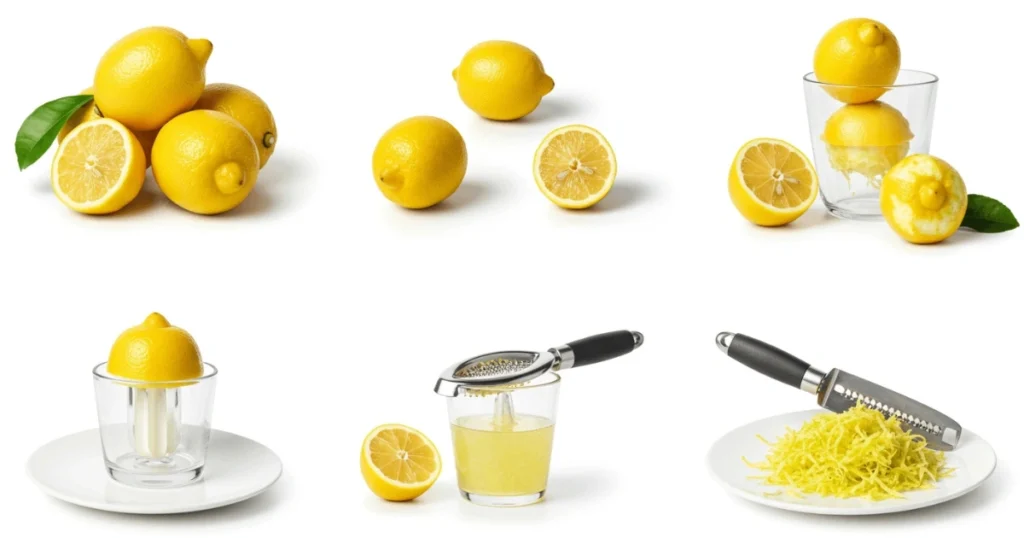
How to Select the Best Lemons for Juicing
Selecting the perfect lemons is crucial for achieving the best juice yield and flavor. Here’s a comprehensive guide to choosing the ideal lemons for juicing:
Visual Indicators:
- Bright, vivid yellow color
- Smooth, firm skin
- No green patches
- Free from blemishes or soft spots
- Medium to large size
Physical Characteristics:
- Weight:
- Should feel heavy for their size
- Heavier lemons contain more juice
- Compare similar-sized lemons by weight
- Texture:
- Slightly glossy skin
- Thin-skinned varieties preferred
- Avoid thick, bumpy rinds
- Firm but slightly yielding when pressed
Ripeness Tests:
- Gentle squeeze test (should yield slightly)
- Sweet citrus aroma
- No musty or fermented smell
- Bright rather than dull appearance
Varieties to Consider:
- Eureka Lemons:
- Year-round availability
- Classic tart flavor
- Good juice content
- Meyer Lemons:
- Sweeter taste
- Thinner skin
- Higher juice content
- Seasonal availability
Storage Tips Until Juicing:
Store separately from other produce
Room temperature for immediate use
Refrigerate for longer storage
Keep away from direct sunlight
Room Temperature vs. Cold Lemons
Understanding the temperature of your lemons before juicing can significantly impact the amount of juice you extract. Here’s a detailed comparison:
Room Temperature Lemons:
- Yield more juice due to relaxed cell walls
- Easier to squeeze and manipulate
- Release essential oils more readily
- Optimal temperature range: 68-72°F (20-22°C)
Benefits of Room Temperature:
- Increased juice extraction (up to 30-40% more)
- Better release of essential oils
- Softer, more pliable fruit
- Enhanced flavor profile
Cold Lemons:
- More firm and rigid structure
- Harder to extract juice
- May require more force when squeezing
- Less aromatic
Temperature Adjustment Tips:
- If Using Cold Lemons:
- Remove from refrigerator 30-60 minutes before juicing
- Place in warm water for 10-15 minutes to speed up process
- Roll on countertop to help break down membranes
- For Optimal Results:
- Store lemons at room temperature if using within 1 week
- Only refrigerate for longer storage
- Avoid extreme temperature changes
- Never microwave to warm up
Pro Tips:
Consider seasonal temperature variations in storage
Plan ahead to ensure lemons are at room temperature
Store only what you’ll use within a week at room temperature
Keep remaining lemons refrigerated
Proper Cleaning Techniques
Before juicing your lemons, proper cleaning is essential to remove any dirt, bacteria, or pesticide residues. Here’s a comprehensive guide to cleaning your lemons properly:
Basic Cleaning Steps:
- Initial Rinse:
- Run under cool water
- Gently rub surface with hands
- Pay special attention to stem area
- Remove any visible dirt or debris
- Deep Cleaning:
- Use natural cleaning solutions
- Avoid soap or chemical cleaners
- Focus on thorough but gentle cleaning
- Pat dry completely before use
Recommended Cleaning Methods:
- Vinegar Solution:
- Mix 1 part vinegar with 3 parts water
- Soak lemons for 2-3 minutes
- Rinse thoroughly with clean water
- Dry with clean cloth
- Baking Soda Method:
- Sprinkle baking soda on wet lemons
- Gently scrub surface
- Rinse thoroughly
- Ensure no residue remains
Pro Tips:
- Clean just before using
- Use room temperature water
- Pay special attention if planning to use zest
- Store cleaned lemons properly
Safety Considerations:
Ensure complete drying before storage
Never use soap or detergents
Avoid harsh scrubbing brushes
Don’t soak for extended periods
Rolling Method for Maximum Juice Extraction
The rolling technique is a crucial pre-juicing step that helps break down the internal membranes of lemons to maximize juice yield. Here’s a detailed guide on this essential method:
Basic Rolling Technique:
- Place lemon on a clean, flat surface
- Apply firm but gentle pressure with your palm
- Roll back and forth for 10-15 seconds
- Rotate lemon while rolling for even pressure
Pressure Guidelines:
- Start with light pressure
- Gradually increase force
- Avoid excessive pressure that could damage fruit
- Roll until lemon feels slightly softened
Advanced Rolling Tips:
- Surface Selection:
- Use clean, smooth countertop
- Avoid rough surfaces
- Keep surface dry
- Ensure proper sanitation
- Temperature Considerations:
- Roll at room temperature
- Avoid rolling cold lemons
- Let refrigerated lemons warm up first
- Maintain consistent pressure
Signs of Proper Rolling:
- Lemon feels slightly softer
- Skin becomes more pliable
- Slight change in texture
- Increased aroma release
Common Mistakes to Avoid:
Insufficient rolling time
Rolling too aggressively
Uneven pressure distribution
Rolling cold lemons
Essential Tools and Equipment
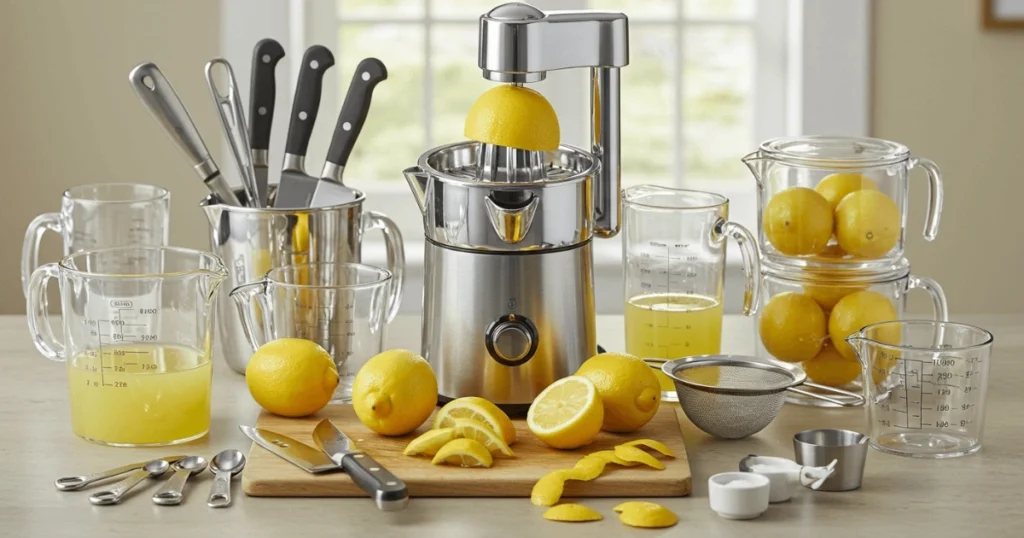
Manual Juicing Options (Hand Press, Reamer)
When it comes to manually extracting lemon juice, there are several effective tools to choose from. Here’s a detailed breakdown of the main manual juicing options:
Hand Press Squeezers:
- Handheld lever-style design
- Perfect for individual lemons
- Provides excellent juice extraction
- Easy to clean and storeReamers:**
- Features pointed ridged cone
- Requires manual rotation
- Good for extracting maximum juice
- Available in various sizes
Key Features to Consider:
- Efficiency:
- Amount of juice extracted
- Effort required
- Speed of operation
- Pulp control options
- Ease of Use:
- Ergonomic design
- Non-slip grip
- Comfortable handling
- Stability during use
Operation Tips:
- Cut citrus fruits in half
- Choose appropriate size reamer for fruit
- Apply steady pressure while juicing
- Rotate fruit for maximum extraction
Capacity Considerations:
- Small handheld squeezers for single servings
- Larger reamers with catch cups (up to 1.5 cups) 1
- Consider volume needs when selecting
Maintenance:
Store properly to maintain quality
Clean immediately after use
Check for durability
Look for dishwasher-safe options
Electric Juicer Recommendations
Based on extensive testing and reviews, here’s a comprehensive guide to selecting the best electric juicers for your lemon juicing needs:
Types of Electric Juicers:
- Masticating (Slow) Juicers:
- Operate at lower speeds
- Better juice extraction
- Preserve more nutrients
- Quieter operation
- Centrifugal Juicers:
- Faster operation
- More affordable
- Good for basic juicing needs
- Typically louder
Key Features to Consider:
- Pulp control options
- Noise levels
- Ease of cleaning
- Durability
- Speed settings
Top Features to Look For:
- Easy-clean components
- Pulp-free extraction capability
- Reasonable noise levels
- Sturdy construction
- Versatility in handling different fruits
Maintenance Tips:
- Clean immediately after use
- Check for dishwasher-safe parts
- Regular maintenance of filters
- Proper storage
Usage Considerations:
Budget constraints
Available counter space
Frequency of use
Volume needs
According to recent testing, the best juicers combine high juice yields with long-term durability at reasonable prices. Some models even offer dual functionality as both blender and juicer for added versatility.
Straining Tools and Containers
Proper straining tools and storage containers are essential for achieving pulp-free juice and maintaining freshness. Here’s a comprehensive guide:
Straining Tools:
- Fine Mesh Strainers:
- Multiple layers for thorough filtration
- Various sizes available
- Easy to clean and maintain – Ideal for small batches
- Cheesecloth Options:
- Reusable nylon varieties
- Multiple layers for better filtration
- Can be cut to size
- Washable and durable
- Nut Milk Bags:
- Fine mesh construction
- Excellent filtration capability
- Multiple usage options
- Best for straining larger quantities
Storage Containers:
- Glass Bottles:
- Wide-mouth options
- Various sizes (16 oz common)
- Dishwasher safe
- Leak-proof lids
- Plastic Containers:
- Multiple color options
- Lightweight
- Perfect for parties/events
- Various capacities (34 oz popular)
Best Practices:
- Clean straining tools immediately after use
- Store juice in airtight containers
- Label containers with date
- Keep stored juice refrigerated
Pro Tips:
opt for UV-protected storage for longer shelf life
Use multiple straining layers for pulp-free juice
Consider container size based on usage needs
Choose BPA-free materials
Storage Containers and Materials
Choosing the right storage containers is crucial for maintaining the freshness and quality of your lemon juice. Here’s a detailed breakdown of the best options:
Glass Containers:
- Benefits:
- No chemical leaching
- Dishwasher safe
- Maintains flavor purity
- Excellent durability
Plastic Options:
- Key Considerations:
- Must be BPA-free
- More lightweight than glass
- Shatter-resistant
- Good for travel 1
Recommended Container Types:
- Glass Bottles:
- Wide-mouth designs for easy filling
- 16 oz size most common
- Airtight caps included
- Reusable and durable
- Storage Sets:
- Multiple size options
- Stackable designs
- Leak-proof seals
- Various capacity options
Best Practices:
- Fill containers completely to minimize air exposure
- Store in refrigerator immediately
- Use dark or UV-protected containers when possible
- Label with date and contents
Storage Duration Guidelines:
Monitor for signs of spoilage
Fresh juice: Up to 72 hours
Refrigerated storage preferred
Avoid freezing in glass containers
Step-by-Step Juicing Process
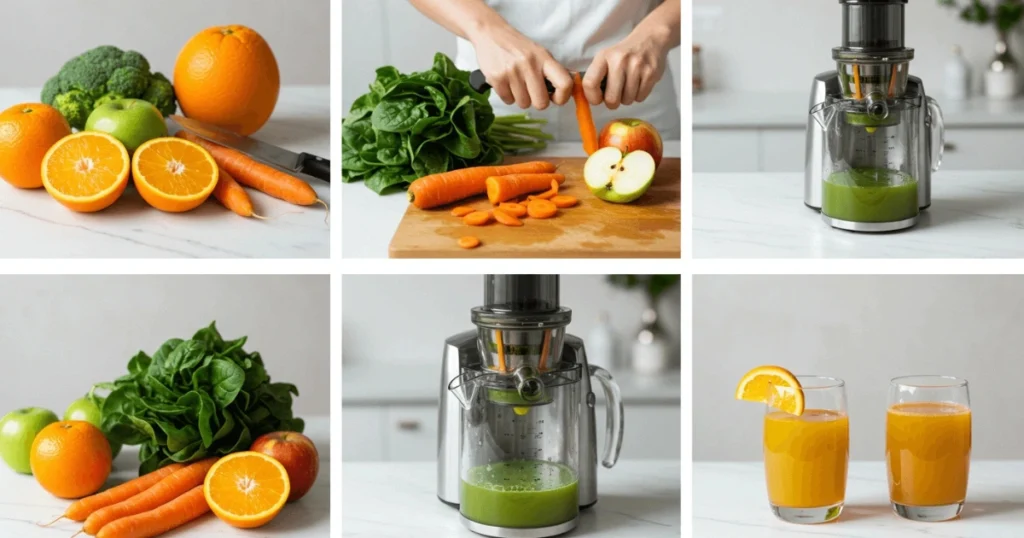
Proper Cutting Technique
The right cutting technique is essential for maximizing juice extraction from lemons. Here’s a detailed guide on the proper method:
Basic Steps:
- Preparation:
- Clean the cutting board
- Use a sharp knife
- Ensure lemons are at room temperature
- Wash lemons thoroughly
- Cutting Direction:
- Cut lengthwise (pole to pole)
- Use firm, even pressure
- Make clean cuts without sawing
- Avoid crushing the fruit
Knife Selection:
- Sharp serrated knife works best
- Clean cuts prevent juice loss
- Maintain knife sharpness
- Use appropriate size knife
Advanced Tips:
- Cut into quarters for manual juicing
- Remove visible seeds before juicing
- Keep cuts uniform for even extraction
- Consider fruit size when cutting
Safety Considerations:
- Use stable cutting surface
- Keep fingers tucked while cutting
- Maintain proper knife grip
- Clean knife between uses
Common Mistakes to Avoid:
Incorrect cutting angle
Dull knives
Uneven pressure
Crushing the fruit
Most Efficient Squeezing Methods
Based on extensive testing and expert recommendations, here are the most efficient methods for squeezing lemons :
Hand Press Method:
- Cut lemon lengthwise
- Place in hand press with cut side down
- Apply firm, even pressure
- Squeeze over open palm to catch seeds and pulp
Rolling + Squeezing Technique:
- Roll lemon on counter first
- Cut and squeeze immediately after rolling
- This method yields excellent results from culinary school testing
- Most efficient for quick juice extraction
Professional Tips:
- Manual Juicing:
- Use appropriate size press for fruit
- Apply consistent pressure
- Work in batches for large quantities
- Consider semi-automatic options for higher volumes
- Maximizing Yield:
- Room temperature fruit works best
- Cut poles to poles (lengthwise)
- Use multiple passes if needed
- Clean equipment between batches
Volume Considerations:
Appropriate pressure application
Small batches: Hand press sufficient
Medium batches: Rotating reamer
Large batches: Electric juicer recommendedEfficiency Factors:**
Tool selection based on quantity
Proper preparation (temperature, rolling)
Correct cutting technique
Straining and Filtering Tips
Here’s a comprehensive guide to effectively strain and filter your freshly squeezed lemon juice :
Multi-Layer Straining Process:
- Initial Straining:
- Use mesh strainer for large pulp/seeds
- Strain immediately after juicing
- Keep strainer elevated above container
- Remove collected pulp regularly
- Fine Straining:
- Multiple layers of cheesecloth
- Fine mesh filters
- Coffee filters for ultra-clear juice
- Nut milk bags for larger batches
Equipment Selection:
- Fine mesh stainless steel strainers
- Unbleached cheesecloth
- Paper coffee filters
- Muslin cloth options
Best Practices:
- Strain while juice is fresh
- Use clean, dry straining tools
- Replace straining materials regularly
- Clean equipment immediately after use
Pro Tips:
- Double-strain for clearest results
- Allow gravity to do the work
- Avoid pressing pulp through strainers
- Change filters when flow slows
Common Mistakes to Avoid:
Skipping multiple straining layers
Rushing the straining process
Using dirty straining tools
Over-pressing pulp
Ideal Dilution Ratios for Drinking
When preparing lemon juice for drinking, proper dilution is key for both taste and enjoyment. Here’s a comprehensive guide to ideal ratios :
Basic Lemonade Ratio:
- 1 part fresh lemon juice
- 3-4 parts water
- Sweetener to taste (optional)
Variations by Use:
- For Drinking Straight:
- 1:2 ratio (lemon:water) for tart preference
- 1:3 ratio for balanced taste
- 1:4 ratio for milder flavor
- For Cocktails:
- 1:1 ratio for sour mix
- 2:1 ratio for concentrated mix
- Adjust based on cocktail recipe
Sweetening Options:
- Simple syrup
- Honey
- Agave nectar
- Stevia
Temperature Considerations:
- Cold water requires more sweetener
- Room temperature better for dissolving sweeteners
- Account for ice dilution
Pro Tips:
Factor in ice melt
Start with less water
Adjust to taste
Consider intended use
Storage and Preservation Tips
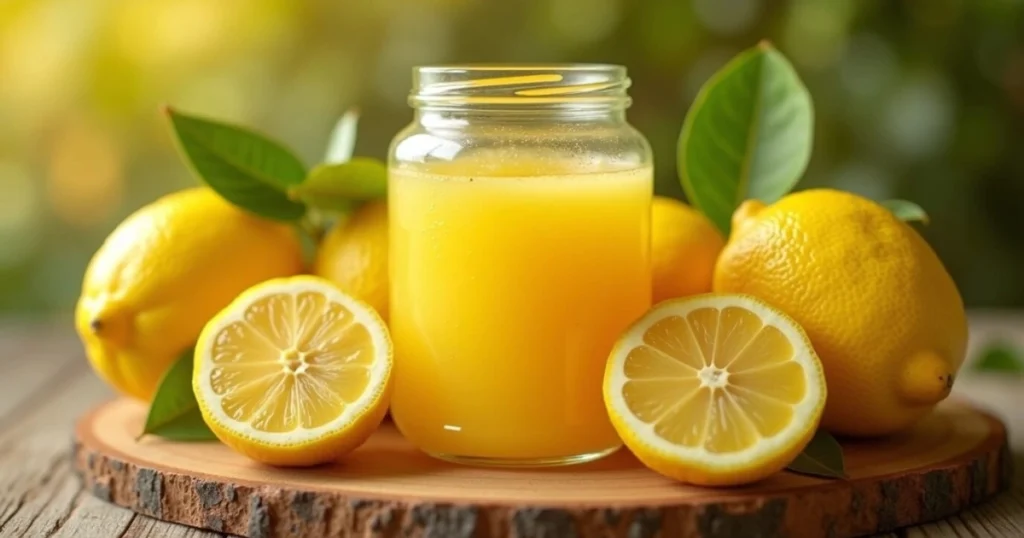
Best Container Types
Here’s a detailed breakdown of the optimal container types for storing lemon juice :
Glass Containers:
- Square or rectangular shapes maximize storage space
- Ideal for refrigerator and freezer storage
- Maintains flavor purity
- Prevents chemical leaching
Plastic Options:
- Best for short-term storage 1
- Rotomolded polyethylene is safe and economical
- Lightweight and portable
- Must be food-grade quality
Key Features to Consider:
- Size and Shape:
- Square/rectangular containers optimize space – Various capacities available
- Consider storage location constraints
- Choose based on typical usage amount
- Sealing Mechanism:
- Airtight seals essential
- Leak-proof design
- Easy-to-clean components
- Durable construction
Storage Capacity Guidelines:
- Small batches: 3.4 oz (100ml) containers
- Medium use: 16-32 oz containers
- Large batches: Up to 265 gallons for bulk storage
Best Practices:
Monitor for wear and damage
Clean thoroughly before use
Check seals regularly
Store away from direct sunlight
Refrigeration Guidelines
Here’s a comprehensive guide for proper refrigeration of lemon juice based on food safety standards :
Temperature Requirements:
- Keep refrigerator at or below 40°F (4°C)
- Monitor temperature regularly
- Avoid storing in door compartments
- Maintain consistent cooling
Time Guidelines:
- The “Two-Hour Rule”:
- Never leave juice at room temperature for more than 2 hours
- Reduce to 1 hour if temperature is above 90°F 1
- Transfer to refrigerator promptly after juicing
Storage Duration:
- Fresh-squeezed juice: 2-3 days optimal
- Store in airtight containers
- Check for signs of spoilage
- Label with preparation date
Best Practices:
- Keep juice away from raw foods
- Store in sealed containers
- Place in main refrigerator compartment
- Avoid overfilling containers
Safety Considerations:
Monitor for any off-odors or changes in appearance
Harmful bacteria multiply rapidly at room temperature
Cold temperatures inhibit bacterial growth
Regular cleaning of storage containers
Freezing Methods
Based on food preservation science, here’s a comprehensive guide to freezing lemon juice effectively :
Preparation Process:
- Strain juice thoroughly before freezing
- Use freezer-safe containers
- Leave headspace for expansion
- Label with date and quantity
Freezing Methods:
- Ice Cube Trays:
- Perfect for small portions
- Easy to measure
- Transfer to freezer bags once frozen
- Standard cube = ~2 tablespoons
- Bulk Freezing:
- Use rigid containers
- Leave 1/2 inch headspace
- Seal tightly
- Avoid glass containers
Temperature Requirements:
- Maintain 0°F (-18°C) or below
- Quick freezing preserves quality
- Avoid temperature fluctuations
- Use back of freezer for consistent temperature
Storage Duration:
- Optimal storage: 4-6 months
- Maximum quality preservation
- Check regularly for freezer burn
- Use oldest juice first
Thawing Guidelines:
- Thaw in refrigerator
- Never at room temperature
- Use within 24 hours of thawing
- Do not refreeze
Quality Preservation:
Freezing helps maintain nutritional value better than other preservation methods, making it an excellent choice for long-term storage of lemon juice.
Signs of Spoilage to Watch For
Based on food safety guidelines, here are the key indicators of spoiled lemon juice :
Visual Changes:
- Change in color from bright to dull 1
- Unusual cloudiness or opacity
- Visible mold growth
- Changes in texture or consistency
Sensory Indicators:
- Unpleasant or off-putting odors
- Changes in normal taste
- Fizzing or bubbling (sign of fermentation)
- Slimy texture development
Container Warning Signs:
- Bulging lids on sealed containers
- Pressure build-up
- Leaking seals
- Unusual container deformation
Storage-Related Issues:
- Temperature abuse indicators
- Separation that doesn’t recombine
- Formation of sediment
- Changes in pressure/seal integrity
Immediate Red Flags:
Unusual textures or films
Any signs of mold
Fermentation odors
Significant color changes
Conclusion:
Making Perfect Fresh Lemon Juice
Creating the perfect fresh lemon juice is both an art and a science that relies on several key factors:
Essential Elements:
- Proper selection of fresh, ripe lemons
- Correct cutting and squeezing techniques
- Appropriate straining methods
- Proper storage solutions
Long-Term Success:
- Following proper storage guidelines
- Maintaining appropriate temperatures
- Using suitable containers
- Monitoring for quality and freshness
The journey from fresh lemon to perfect juice requires attention to detail and proper technique, but the result is worth the effort. Whether you’re using it for cooking, beverages, or health purposes, properly prepared and stored lemon juice can enhance your daily routine with its fresh, vibrant flavor and numerous health benefits.
Health and Nutritional Benefits:
- Rich in Vitamin C
- Natural antioxidants
- Essential minerals
- Natural enzymes
Therapeutic Uses:
- Immune system boost
- Digestive aid
- Liver cleansing
- Natural hydration
Innovative Recipes:
Healthy Beverages:
- Mint-infused lemon juice
- Ginger lemon tonic
- Warm honey lemon drink
- Refreshing cucumber lemon water
Additional Preparation Tips:
- Adding fresh herbs
- Combining with seasonal fruits
- Avoiding excess sweeteners
- Using pure mineral water
Creative Applications:
Culinary Uses:
- Marinades and dressings
- Baking and desserts
- Preserving other fruits
- Natural food brightener
Lifestyle Integration:
Skin care applications
Morning wellness routine
Post-workout hydration
Natural cleaning solutions
Share Your Experience
very nice juices
I made this juice and enjoyed drinking it while watching my favorite series. I was very happy and the way to prepare it was easy simple. THANK YOU
